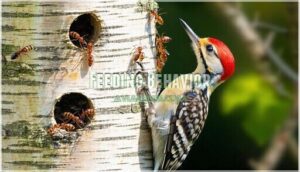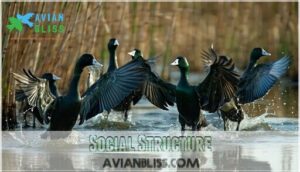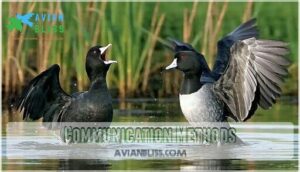This site is supported by our readers. We may earn a commission, at no cost to you, if you purchase through links.
 You’ll spot an American coot by its jet-black feathers and bright white bill cutting through wetland waters.
You’ll spot an American coot by its jet-black feathers and bright white bill cutting through wetland waters.
These aren’t ducks despite their swimming prowess – they’re rails with lobed toes perfect for paddling and diving.
Coots call marshes, ponds, and lakes home across North America, from Canada to Mexico.
They’re territorial fighters who’ll chase rivals across water in dramatic running displays.
You’ll hear their harsh "kek-kek-kek" calls echoing across wetlands as they forage for aquatic plants and small fish.
Their oversized feet make them surprisingly good land walkers too.
These feisty birds pack surprising behaviors that’ll change how you view wetland wildlife.
Table Of Contents
Key Takeaways
- You’ll spot American coots by their charcoal-gray feathers, bright white bills, and oversized lobed feet that help them swim and walk on water vegetation.
- You won’t confuse coots for ducks once you know they’re actually rails—aggressive fighters with unique social hierarchies and harsh “kek-kek-kek” calls.
- You’ll find coots thriving across North America’s wetlands, from marshes and ponds to city parks and sewage treatment plants, showing impressive adaptability.
- You’ll see coots diving underwater for food, building floating nests anchored to marsh plants, and playing a crucial role in wetland ecosystems by controlling vegetation and recycling nutrients.
American Coot Overview
If you’ve ever spotted a dark, chicken-like bird paddling around a pond with what looks like a white beak, you’ve likely seen an American Coot.
These distinctive waterbirds are easy to recognize once you know their key features: charcoal-gray plumage, a bright white bill, and large feet that help them swim and walk on water vegetation.
Spot these waterbirds by their charcoal-gray feathers, white bills, and oversized feet that let them walk on lily pads.
Physical Description
You’ll spot an American coot by its distinctive charcoal-gray plumage and striking white bill.
This unique waterbird’s appearance makes identification straightforward once you know what features to look for.
- Plumage Details: Charcoal-gray body with velvety black head and neck
- Bill Morphology: Thick, stubby white bill with dark band near tip
- Leg Coloration: Greenish-hued legs and feet with lobed toes for swimming
- Juvenile Appearance: Paler plumage with orange neck markings and pinkish-red bills
- Size Variation: Males slightly larger than females, both crow-sized
Their beak morphology varies based on specialized feeding strategies.
Size and Weight
You’ll find the American coot measures between 15.5 to 16.9 inches in length, roughly two-thirds the size of a mallard.
These waterbirds weigh 21.2 to 24.7 ounces with a wingspan stretching 23 to 25 inches.
Males typically grow slightly larger than females, showing subtle sexual dimorphism in adult birds.
| Measurement | Range |
|---|---|
| Length | 15.5-16.9 inches |
| Weight | 21.2-24.7 ounces |
| Wingspan | 23-25 inches |
The American coot’s size can be summarized by its length and weight, which are key factors in identifying the species.
Distinctive Features
You’ll recognize an American coot by its distinctive white bill and red eyes that stand out against dark plumage.
The unique bill features a frontal shield extending onto the forehead, while lobed toes help with swimming.
Juvenile plumage appears paler with orange neck markings, making coot identification easier across age groups, and the bird’s overall appearance is characterized by its dark plumage.
Habitat and Range
You’ll find American coots across freshwater lakes, ponds, marshes, and wetlands throughout much of North America, from the Great Lakes region down to Mexico and the Caribbean islands.
These adaptable birds breed in shallow waters with emergent vegetation and winter wherever open water remains, including coastal marshes and even water treatment plants, which can be considered as winter habitats.
Breeding Grounds
You’ll discover American Coots building their nests in shallow freshwater marshes across North America.
These adaptable birds choose locations with abundant marsh vegetation, creating floating nesting platforms anchored to emergent plants like cattails and bulrushes.
The study of American Coot products can provide insights into their behavior and habitat preferences.
- Shallow wetlands with dense emergent vegetation provide ideal nest sites
- Floating platforms made of dead vegetation serve as secure nesting bases
- Great Lakes region through central Canada offers prime breeding habitat
Wintering Areas
American coots transform into winter wanderers, abandoning their breeding marshes for diverse aquatic refuges.
You’ll spot these adaptable birds in coastal habitats, saltwater bays, and ice-free freshwater lakes.
Their migratory nature leads them along established migration routes to southern wetland ecosystems, where they gather in impressive flocks until spring calls them home.
Migration Patterns
Migration follows predictable patterns you can track throughout the year.
These birds use established flyway routes, timing their seasonal movements with weather changes and food availability at stopover sites.
- Major Flyway Routes – Pacific, Central, Mississippi, and Atlantic corridors guide migratory movements across North America
- Seasonal Movements – Spring migration peaks March-May; fall migration occurs August-November depending on regional climate
- Altitude Changes – Coots fly at relatively low altitudes, typically under 1,000 feet during migration
- Stopover Sites – Wetlands, lakes, and marshes serve as critical refueling stations during long-distance travel
- Migration Timing – Northern populations migrate farther than southern residents, with some staying year-round in mild climates
Behavior and Characteristics
You’ll quickly notice that American coots are surprisingly aggressive birds despite their duck-like appearance, often engaging in fierce territorial battles with their powerful lobed feet.
Don’t let their duck-like demeanor fool you—coots are feathered fighters ready to rumble.
These adaptable waterbirds display fascinating feeding behaviors, from dabbling at the surface to diving underwater, while maintaining complex social hierarchies through distinctive calls and physical displays, showcasing their unique ability to thrive in various environments with complex social hierarchies.
Feeding Behavior
Throughout wetlands, you’ll spot these versatile feeders dabbling, diving, and grazing like aquatic Swiss Army knives.
American coots employ multiple foraging methods to capture their omnivorous diet of plants, insects, and small fish. Understanding their feeding habits requires knowledge of fundamental bird feeding habits basics.
| Feeding Technique | Target Food |
|---|---|
| Surface dabbling | Algae, floating vegetation |
| Underwater diving | Small fish, aquatic insects |
| Land grazing | Grasses, seeds, grains |
Their lobed toes and strong legs make them efficient underwater hunters. You’ll see them pattering across water surfaces before plunging down for crustaceans and tadpoles. These opportunistic feeders even steal food from ducks nearby.
Social Structure
You’ll often spot coots in flocks that showcase complex Flock Dynamics and strict Dominance Hierarchy patterns.
These aggressive birds establish clear territorial boundaries through displays and confrontations.
Group Size varies seasonally, with larger gatherings during migration.
Pair Bonding occurs during breeding season, but outside this period, coot behavior emphasizes competition over cooperation.
Their bird social behavior creates structured communities where stronger individuals dominate prime feeding spots, highlighting a clear Dominance Hierarchy.
Communication Methods
Listen closely to a coot’s chatter and you’ll hear nature’s most expressive waterbird.
These vocal performers use diverse communication methods to navigate their aquatic social world with remarkable precision and effectiveness.
Key communication methods include:
- Vocal calls – Honking and grunting sounds for territory defense and mate attraction
- Visual displays – Threat postures with raised wings during aggressive encounters
- Alarm signals – Sharp warning calls to alert flocks of approaching danger
Nesting and Reproduction
You’ll find American coots are skilled nest builders that create floating platforms in shallow marshes using dead vegetation.
These dedicated parents work together through a lengthy breeding process that spans several months from nest construction to fledging.
Nest Placement
You’ll find American coots building their floating nest-platforms in shallow water areas with thick emergent vegetation.
These smart birds anchor their nestlike platform to cattails, bulrushes, or other sturdy marsh plants in water depths of 6-24 inches.
The nest orientation faces open water for quick escape routes, while platform stability depends on strong vegetation anchors and daily maintenance.
Proper nest box placement, including consideration of essential nest placement strategies, is vital for the success of various bird species, including those that build complex nests like the American coot, which requires careful consideration of complete concepts and nest placement strategies to ensure the success of these bird species.
Nest Description
You’ll find American coot nests are impressive floating platforms made from dead cattails and marsh vegetation.
These nestlike platforms stay anchored to standing plants, creating stable brood platforms that rise and fall with water levels.
The construction of these nests utilizes floating nest materials to guarantee their stability.
What makes coot nesting remarkable:
- Floating platforms that adapt to changing water levels like nature’s houseboats
- Daily maintenance prevents the nest from rotting and collapsing
- Smart anchors using living vegetation keep everything secure during storms
Egg Laying and Incubation
You’ll find that coots lay 6-11 buff-colored eggs with brown speckles in their floating nests.
Both parents share incubation duties for 21-25 days, with males typically taking night shifts.
The clutch size averages 8-12 eggs, and coot chicks leave the nest within hours of hatching to swim alongside their parents, which is a unique behavior.
Conservation and Ecology
You’ll find American coots thriving across much of North America, though their numbers have dropped in some eastern regions over recent decades.
These adaptable waterbirds play a key role in wetland ecosystems by controlling aquatic vegetation and serving as prey for larger predators like hawks and alligators, highlighting their importance in maintaining the balance of ecosystems.
Population Trends
The American coot population exceeds 4 million individuals across North America, showing generally stable numbers despite some regional decline.
Breeding Bird Survey data reveals population dynamics linked to drought cycles and wetland availability.
While habitat loss threatens local populations, conservation efforts through wetland restoration have helped stabilize coot population trends in many areas, maintaining healthy migration patterns.
Effective conservation strategies often involve migratory bird conservation techniques to protect species like the American coot.
Ecological Niche
Your backyard pond friend plays a bigger role than you’d think.
American coots control plant growth by munching on submerged vegetation while stirring up sediment that helps other aquatic creatures thrive.
These wetland residents recycle nutrients and create food webs that support entire ecosystems through their diverse diet.
- Vegetation Control: Coots eat up to 80% plant matter, naturally managing aquatic plant levels in wetland habitats
- Nutrient Cycling: Their feeding disturbs sediment, releasing nutrients that fuel the entire food chain ecosystem
- Habitat Engineering: Constant movement aerates water and creates microhabitats for invertebrates and fish species
Climate Vulnerability
Climate change threatens you’ll see fewer coots in familiar wetlands.
Temperature shifts and weather extremes disrupt their breeding cycles, while habitat loss from sea rise eliminates coastal marshes.
Northern populations face the biggest climate vulnerability as warming reduces suitable wetland habitats by 12% by 2050.
Ecosystem disruption affects their food sources and migration timing.
Frequently Asked Questions (FAQs)
Is American coot rare?
No, you won’t struggle to spot these birds. American coots remain abundant across much of North America, though they’ve declined somewhat in eastern regions recently.
Can an American coot fly?
Yes, you’ll see American coots fly, though they struggle getting airborne.
They must patter across water while flapping furiously to take off.
Once flying, their broad wings and large feet create a distinctive flight pattern.
Do American Coots dive underwater?
You’ll often see coots diving underwater to grab food from the bottom.
They’ll disappear completely beneath the surface, using their strong legs to propel themselves down after aquatic plants, insects, and small fish.
What is a waterborne American coot?
Like a feathered submarine traversing marsh waters, you’ll spot a waterborne American coot swimming with its distinctive white bill and dark plumage.
Diving underwater to forage for aquatic plants and small creatures is a key behavior of the American coot, highlighting its distinctive adaptation to its aquatic environment.
Where can I find American coots?
You’ll spot these chunky waterbirds on freshwater lakes, ponds, marshes, and wetlands across North America. They’re common in city parks, golf courses, and even sewage treatment facilities.
What does American coot mean?
American coot" refers to a chunky, chicken-like waterbird with dark plumage and a distinctive white bill.
You’ll recognize this aquatic species by its aggressive behavior and unique lobed toes for swimming.
Are American coots a duck?
Don’t judge a book by its cover—you’ll find coots aren’t actually ducks despite their similar appearance.
They’re rails, related to cranes, with distinctive lobed toes instead of webbed feet like true ducks.
Where do you find American Coots?
You’ll find these adaptable waterbirds across North America in freshwater lakes, ponds, marshes, and wetlands.
They’re common on golf courses, city park ponds, and even sewage treatment facilities, mixing freely with ducks.
Are American Coots good to eat?
Like treasure hidden beneath murky waters, these birds offer edible meat that’s surprisingly flavorful.
You’ll find coots taste similar to duck but with a slightly stronger, gamier flavor.
They’re legally hunted waterfowl in most states during hunting season.
Are American Coots rare?
No, you won’t find American Coots rare – they’re actually quite common across North America.
While their numbers have dropped in eastern areas recently, they’re still abundant in many regions and easily spotted on most ponds and lakes.
Conclusion
Like a black sentinel guarding wetland secrets, the American coot stands as nature’s overlooked treasure.
You’ve discovered a remarkable bird that defies simple classification—neither duck nor typical water bird, but something uniquely adaptive.
Remember those lobed toes and territorial displays when you next visit marshlands.
The American coot’s harsh calls and fearless nature make it unmistakable once you know what to watch for.
These resilient birds continue thriving across North America’s waterways, proving that sometimes the most common species hold the greatest surprises for observant wildlife enthusiasts, being a true nature’s treasure.











